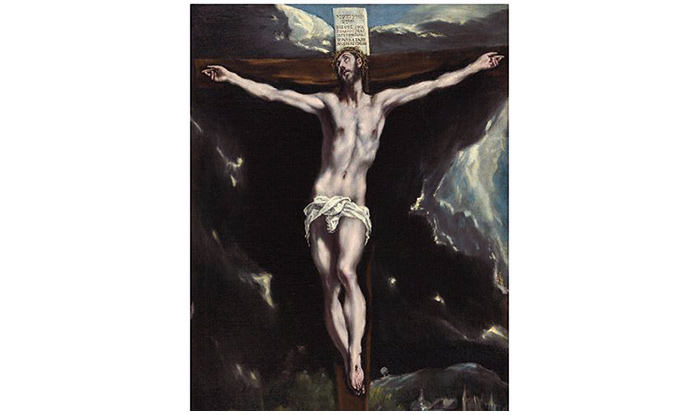For our sake he was crucified under Pontius Pilate;
Nicene Creed
he suffered, died, and was buried.
On the third day he rose again,
in fulfillment of the Scriptures;
he ascended into heaven
and is seated at the right hand of the Father.
He will come again in glory
to judge the living and the dead,
and his kingdom will have no end.
For our sake
Every time we pray the Nicene Creed, we profess our faith in Jesus Christ and his saving deeds for us. These few sentences summarize the whole truth of our redemption. But the words have become so familiar that they trip off our tongues, almost without thought. We have memorized them and easily say them by heart, so to speak. But how deeply do we really understand their meaning? How can we truly grasp by heart the profound truths they contain?
In this guide, we will read and study Scripture texts that help us fathom Jesus’ tremendous love as revealed through his passion, death, and resurrection. By studying the Scriptures about the meaning and power of the cross and prayerfully contemplating our crucified Lord we will come to know the depths of his mercy and compassion toward us, sinners undeserving of such sacrificial love.
The Paradox of the Cross
“When mankind was estranged from him by disobedience, God our Savior made a plan for raising us from our fall and restoring us to friendship with himself,” wrote St. Basil the Great in the fourth century. “According to this plan Christ came in the flesh, he showed us the gospel way of life, he suffered, died on the cross, was buried, and rose from the dead. He did this so that we could be saved by imitation of him, and recover our original status as sons of God by adoption.”
In words echoing the Creed, Basil clearly and effectively reviews the history of humankind’s redemption, the story of our need for salvation, and how God brought that about through his Son Jesus. Central to our salvation is Christ’s death on the cross: Through his sacrifice, the Son of God conquered sin and Satan, overcame death’s stranglehold on the human race, and restored us to union with our Creator. Jesus’ cross is a greatest of paradoxes: Through his death we have received life. The cross may seem an instrument of torture in the eyes of unbelievers, but to those who do believe, it is the instrument of our salvation. “For the message about the cross is foolishness to those who are perishing, but to us who are being saved it is the power of God” (1 Corinthians 1:18).
St. Paul was the first to put into writing a “theology of the cross.” In his letter to the church at Corinth, he explained, “In Christ God was reconciling the world to himself, not counting their trespasses against them…. For our sake he made him to be sin who knew no sin, so that in him we might become the righteousness of God” (2 Corinthians 5:19, 21). What good news it is that God reconciled the world to himself through Christ and does not count our sins and failings against us! But we are forgiven, not because God overlooked our trespasses, but because Christ took them upon himself. Reconciliation with God was won for us at the price of Jesus’ death on the cross. His passion and crucifixion are a stark reminder that our salvation, forgiveness of our sin, is costly.
Not only did the cross bring us eternal life, it also brings us a more abundant life here and now. Jesus “bore our sins in his body upon the cross, so that, free from sin, we might live for righteousness” (1 Peter 2:24). His death on the cross won us victory over our sins – every one of them. Though his cross, Jesus has set us free from all that separates us from our Lord and prevents us from following him: our disobedience, our pride, our anger, and our self-centeredness. In Christ, we die to this “old self,” and in Christ we rise to the new.
Embraced by Christ’s love
In the first session of this guide [The Life-Giving Power of the Cross: Sharing in Christ’s Victory], we look at the evangelist John’s eyewitness account of the historical event of Jesus’ death. This text brings home to us the physical horror of the crucifixion, one of the most dreadful and excruciatingly painful forms of execution ever devised. Here we come face to face with Jesus’ passion – that is, his burning love and passionate ardor for humankind and his fervent desire to save us – that led him to his passion on the cross. When we look to Golgotha, we see what love is. As Father Richard John Neuhaus once wrote, “The perfect self-surrender of the cross is, from eternity to eternity, at the heart of what it means to say that God is love.” It is as if Jesus’ arms are outstretched on the cross to take us into his loving embrace.
In the second session we will meet the Risen Lord and examine how his death was not simply a tragedy but also a triumph. Through dying on the cross and rising victoriously, Christ entered into his glory. Overcoming the curse of death that was upon us all, he opened the way for us to share glorious, eternal life with him and the Father.
The first two sessions include many references to texts from the ancient Hebrew Scriptures – the Christian Old Testament. As we study them, we will see that it was “in accordance with the scriptures” (1 Corinthians 15:3-4) that Jesus passed through all that he did for our sake. And as we come to recognize how Old Testament prophecies and “prefigurements” and “types” are fulfilled in Christ in the New Testament, we will grow in our understanding and appreciation of God and the marvelous plan of salvation his Son has carried out for us.
Contemplating Christ’s passion
Thomas Aquinas once noted that “the Passion of Christ is enough to serve as a guide and model throughout our lives.” But it is especially in the season of Lent that our thoughts and our hearts are turned to Christ’s passion and crucifixion. Lent is a time for us to remember with gratitude Jesus’ sacrifice – the price of our atonement paid for by his own blood. It is also a time for us to reflect on our need for this reconciliation, a time to ask where we have sinned or turned a deaf ear to God’s call to us, and to repent.
Allow Paul’s cry, “Be reconciled to God” (2 Corinthians 5:20), which we hear during the Ash Wednesday liturgy, to strike deeply at your heart. He persistently appeals to us not to reject God’s offer of salvation, “not to accept the grace of God in vain” (6:1). “Now” – today, each and every day – is “the acceptable time” for us to return to the Lord, “now is the day of salvation” (6:2) for us. During the forty days of Lent, open your heart to the mystery of the cross and its meaning for you personally. Then, at the Easter Vigil, the night-watch of the resurrection, enter into the joy of Christ’s victory as the church sings its great proclamation, the Exsultet:
This is the night when Christians everywhere,
washed clean of sin
and freed from all defilement,
are restored to grace and grow together in holiness.This is the night when Jesus Christ
broke the chains of death
and rose triumphant from the grave. . . .Most blessed of all nights, chosen by God
to see Christ rising from the dead!Of this night Scripture says:
“The night will be clear as day:
it will become my light, my joy.”The power of this holy night
dispels all evil, washes guilt away,
restores lost innocence, brings mourners joy;
it casts out hatred, brings us peace, and humbles earthly pride.Night truly blessed, when heaven is wedded to earth
and man is reconciled with God!
Let us take hold of the life-giving power of the cross so that we can share in the victory that Jesus won for us. Our hope is that on the last day, we will be united with him in his resurrection, healed and transformed in body, mind, and spirit and wholly conformed to his image. “Now to him who by the power at work within us is able to accomplish abundantly far more than all we can ask or imagine, to him be glory in the church and in Christ Jesus to all generations, forever and ever. Amen” (Ephesians 3:20-21).
This article is excerpted from The Life-Giving Power of the Cross: Sharing in Christ’s Victory, by Jeanne Kun, published by The Word Among Us Press, © 2011). Used with permission.
Top image credit: Christ on the Cross, painting by El Greco (1585-95), image in the public domain.
Jeanne Kun is a noted author, and a member of Bethany Association, an international, ecumenical association of women living single for the Lord in various communities of The Sword of the Spirit, and a senior woman leader in the Word of Life Community, Ann Arbor, Michigan, USA.



